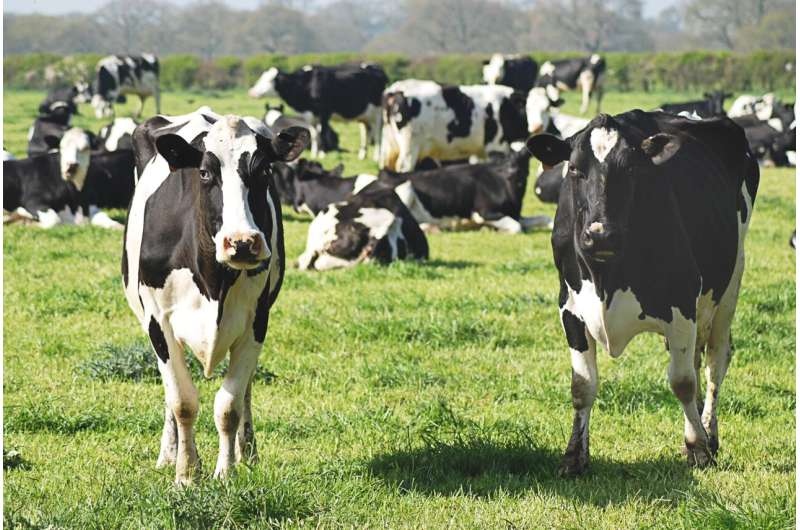This article has been reviewed according to Science X's editorial process and policies. Editors have highlighted the following attributes while ensuring the content's credibility:
fact-checked
peer-reviewed publication
trusted source
proofread
Change food choices to increase chances of tackling global warming, say researchers

Action to protect the planet against the impact of climate change will fall short unless we reduce greenhouse gas (GHG) emissions from the global food system, which now makes up a third of man-made GHG emissions, a new study reveals.
The largest emission increase within food supply chains is triggered by beef and dairy consumption in rapidly developing countries, such as China and India, while emissions per head in developed countries with a high percentage of animal-based food declined.
The United Nations projects that an additional 70% of the current food demand will be needed to feed the world's estimated population of 9.1 billion by 2050.
Publishing their findings (15 June) in Nature Food, an international group of scientists led by the Universities of Groningen and Birmingham, say that the growth of the global population and rising demand for emission-intensive food are likely to boost emissions further.
"A global shift in diets, including reducing excessive intake of red meat and improving shares of plant-based protein—will not only reduce emissions but avoid health risks such as obesity and cardiovascular disease," stated corresponding author, Prof. Klaus Hubacek from the University of Groningen.
Another corresponding author, Dr. Yuli Shan, from the University of Birmingham, commented, "The agrifood system drives global land use and agricultural activities—contributing to around one-third of global anthropogenic greenhouse gas. Population growth, expansion of food production, and an increase in animal-based diets are likely to further increase emissions and squeeze the global carbon budget."
The first author, Yanxian Li, a Ph.D. student at the University of Groningen added, "Mitigating emissions at every stage of food supply chains from production to consumption is critical if we are to limit global warming. However, widespread and lasting diet shifts are very difficult to achieve quickly, so incentives that encourage consumers to reduce red meat or buy products with higher environmental dividends could help to reduce food emissions."
Researchers analyzed data linking emissions to consumers between 2000 and 2019, revealing that in 2019, food consumption in the five highest emitting countries, China (2.0 Gt CO2-eq), India (1.3 Gt), Indonesia (1.1 Gt), Brazil (1.0 Gt) and the U.S. (1.0 Gt), was responsible for more than 40% of global food supply chain emission.
Annual global GHG emissions associated with food increased by 14% (2 Gt CO2-eq) over the 20-year period. The substantial increase in consuming animal-based products contributed to some 95% of the global emissions rise, accounting for almost half of total food emissions. Beef and dairy contributed 32% and 46% of the increase in global animal-based emissions.
Consumption of grains and oil crops is responsible for 43% (3.4 Gt CO2-eq in 2019) and 23% (1.9 Gt CO2-eq) of global plant-based emissions respectively, while rice contributes to over half of the global grain-related emissions (1.7 Gt CO2-eq), with Indonesia (20%), China (18%), and India (10%) being the top three contributors.
Soybean (0.6 Gt CO2-eq) and palm oil (0.9 Gt CO2-eq) have the largest shares in global emissions from oil crops with 30% and 46%, respectively. Indonesia, the world's leading consumer of palm oil, has the largest emissions from palm oil (35% of the global total in 2019), followed by Southeast Asia (13%), Western Europe (10%), and China (9%).
The study reveals considerable differences regarding emission patterns and the reasons behind these trends—classifiable as follows:
- Countries with high per capita food emission levels and dominant livestock emissions (mainly from red meat) (North America, Australia, Latin America & Caribbean);
- Developed countries which heavily rely on imports and outsource substantial amounts of food-related emissions (Japan and Europe);
- Rapidly developing countries with substantial emission increase driven by rapid population growth or improved living standards (China, South Asia, Near East & North Africa); and
- Countries with emission-intensive production, mainly with extensive land-use change activities (Brazil, Indonesia, and South and Central African regions).
The researchers also note that a series of trade policies are accelerating emissions through increasing food imports from countries/regions with emission-intensive production—for example, the EU's Green Deal encourages less intensive agriculture in Europe and increasing imports of agricultural products from countries such as Brazil, U.S., Indonesia, and Malaysia.
More information: Yanxian Li et al, Changes in global food consumption increase GHG emissions despite efficiency gains along global supply chains, Nature Food (2023). DOI: 10.1038/s43016-023-00768-z www.nature.com/articles/s43016-023-00768-z
Journal information: Nature Food
Provided by University of Birmingham





















